-
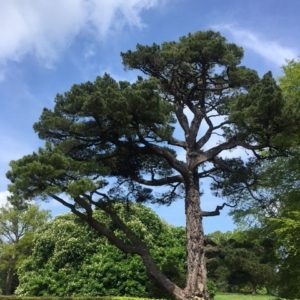
Monterey Pine Seed
Pinus radiata£6.00 – £30.00 inc. VATMonterey Pine is the most widely planted pine in the world, although it is endangered in its natural habitat. It is extremely important for timber production Older trees make a good windbreak. In UK , grows best in areas with mild wet winters, in fertile sites. In the wild it grows on the Californian coastal fringe and is one of the trees in which Monarch butterflies overwinter. It’s huge cones open in heat, but tend to stay on the tree for years. They are an uneven shape at the base. The needles grow in groups of 3, fresh green close to and blackish from afar. On mature trees the bark develops very deep fissures.
Cone pic courtesy of S. Rae from Scotland, UK/CC BY 2.0
Not for forestry purposes.
-
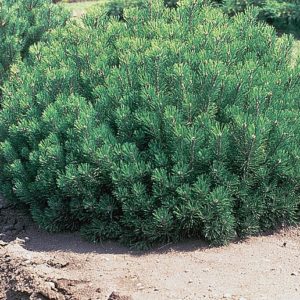
Mountain Pine (Pumilio) Seed
Pinus mugo pumilio£5.00 – £16.50 inc. VATA dwarf form of the Mountain Pine that often grows prostrate but can reach 2m in height, slowly. Great for adding substance and winter interest to alpine and scree gardens and works well in containers. Shortish dark green needles look fine in the frost
pic courtesy of UUSDA-NRCS PLANTS DATABASE/ Herman, D.E. et al. 1996. North Dakota tree handbook. USDA NRCS ND State Soil Conservation Committee; NDSU Extension and Western Area Power Admin., Bismarck, ND., Public domain, via Wikimedia Commons
-
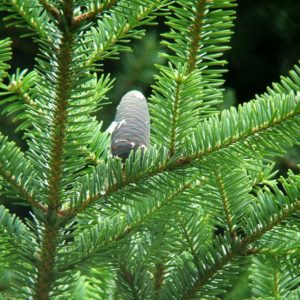
Nikko Fir Seed
Abies homolepis£8.50 inc. VATAn uncommon, well shaped ornamental fir, not too wide-spreading when young. It has pinkish pale grey flakey, bark, dense, dark green shiny needles, white underneath, and dark blue cones. Winter buds are usually coated in sticky resin. The cones occur all over the tree rather than just at the top, like other Firs, which makes them particularly decorative. A small number are produced for Christmas trees and for Christmas foliage. In the wild in Japan, it grows naturally with flowering cherries and Magnolia. Tolerant of pollution and exposed conditions.
-
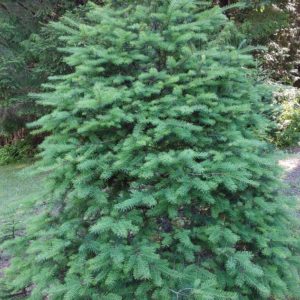
Noble Fir Seed
Abies nobilis / procera£5.00 – £10.00 inc. VATNoble Fir is a beautiful coniferous tree noted for its blue-green needles. They grow densely packed, often hiding the brown new shoots and buds. It is used in floristry as well as for Christmas trees. It grows on the western side of America, but further south than the Red Fir, to which it is closely related.
-
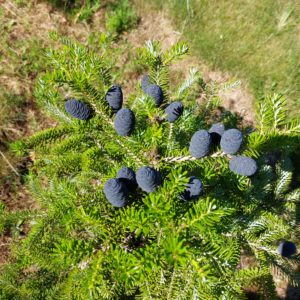
Nordmann/Caucasian Fir Seed
Abies nordmanniana£6.00 inc. VATThe Nordmann is a fir of great ornamental value and much valued in ‘non-drop’Christmas tree production for its dense foliage. Wonderful, even, conical shapes develop and the foliage is soft-looking, not spikey. Blue cones
-
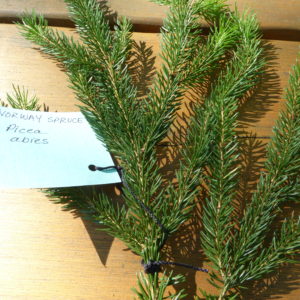
Norway Spruce Seed
Picea abies£5.00 – £12.00 inc. VATNorway Spruce is the traditional and most widely grown Christmas tree and makes a good stand-alone tree. It is used as a prickly security hedge in many alpine villages. It makes a virtually impenetrable barrier and doesn’t need much pruning or trimming once the tops have been taken out.
Not for forestry purposes.
-
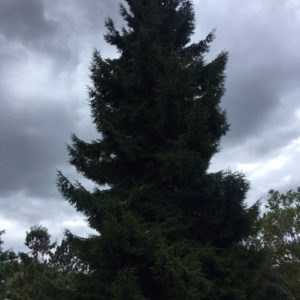
Oriental Spruce Seed
Picea orientalis£5.00 – £10.00 inc. VATOriental Spruce is a large densely branched tree with branches and dark green leaves down to ground level. The needles are short and tightly packed too, giving a neat and tidy effect. The young cones are 10cm long and purple, maturing to brown, curved. A seedling was selected, golden needled, which has been vegetatively propagated to give a named cultivar ‘Skylands’
-
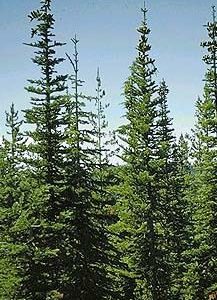
Pacific Silver Fir Seed
Abies amabilis£5.00 – £22.00 inc. VATPacific Silver Fir is a native of north-west America In Europe it is grown as an ornamental tree. It is quite often found growing with Douglas Fir. Amabilis means beautiful and it can resemble Abies nordmanniana, with dark green soft needles, white undersides. The timber is not very useful for construction, just for pulp. Sometimes grown for the Christmas market.
pic courtesy of Orjen at the English-language Wikipedia, CC BY-SA 3.0 , via Wikimedia Commons
-
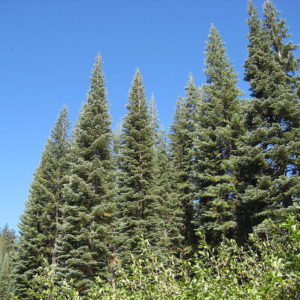
Red Fir Seed
Abies magnifica£5.00 – £20.00 inc. VATRed Fir forms the great conifer forests of the Sierra Nevada of California. It has long blue-green needles and purple cones of up to 20 cm long. The bark turns red as the tree ages. Mature trees grow into a slim conical shape. Closely related to Noble Fir but it doesn’t have a groove down the centre of the needle and the needles are less densely packed along the branch. Used for timber, pulp and Christmas trees
PIC COURTESY OF Tyler Karaszewski from Alameda, CA, USA, CC BY 2.0 via Wikimedia Commons
-
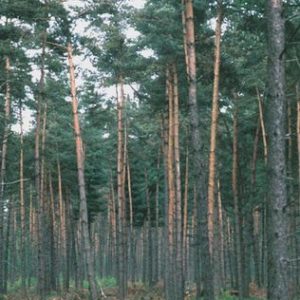
Scots Pine Seed
Pinus sylvestris£5.00 – £20.00 inc. VATScots Pine is the only pine native to Britain and is easily recognised by its attractive reddish bark. It’s needles grow in pairs and are quite long when the tree is young and fast growing, but become shorter growing with age. It has a conical growth habit when young, making it popular for Bonsai production and increasingly for use as a Christmas tree. When mature the tree makes a wonderful architectural shape. Once extensively covering land in Scotland, there are now only a few remaining ancient Caledonian Forests due to the iconic Scots Pine being used as a timber tree. Conservation bodies and landowners are trying to rectify this. (Trees for Life)
Not for forestry purposes.
-
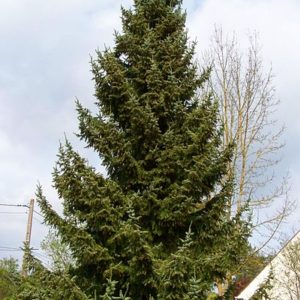
Serbian Spruce Seed
Picea omorika£5.00 – £23.00 inc. VATSerbian Spruce is a very adaptable spruce which quickly forms a tall slender tree with short drooping branches and dark green/grey needle leaves, with blue undersides. It is sometimes used as a Christmas Tree, but the needles are very prickly and sharp. Makes a good barrier when young and a lovely specimen tree on maturity. Dark purple cones turn brown as they ripen.
pic courtesy of UBothFr91, CC BY-SA 4.0 <https://creativecommons.org/licenses/by-sa/4.0>, via Wikimedia Commons
-
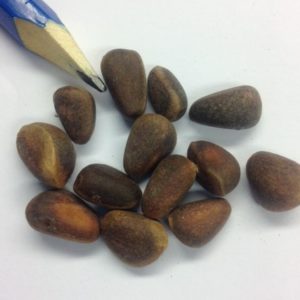
Siberian Pine Seed
pinus siberica£8.50 inc. VATThe Siberian Pine is related to Pinus cembra. It is extremely hardy, slow growing and long-lived, particularly suited to cold climates where it is often grown as a specimen tree. The needles grow in bundles of five. This is one of the Pines which have shown resistance to White Pine Blister Rust. and so is being used in breeding programmes. The cones produced are quite bulky and heavy, the seeds inside are eaten as a good source of oil, sold in Russia as Cedar Nuts. It is quite rare in its native habitat.
-
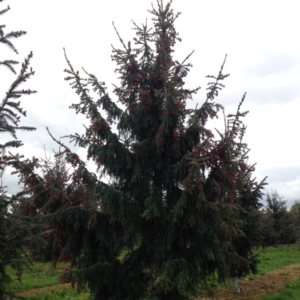
Sitka Spruce Seed
Picea sitchensis£5.00 – £12.00 inc. VATSitka Spruce is probably one of the most important species of conifer from an economic viewpoint. It thrives on damp sites and poor soils. Used extensively for timber and pulp production, but also can be used for Christmas trees. Picture shows an enormous tree in the Benmore Botanic Gardens, near Dunoon(www.rbge.org.uk/visit/benmore-botanic-garden). Sitka can be used as a relaxed hedge – just chop out the leader and it will bush out to make a prickly barrier.
Not for forestry purposes.
-
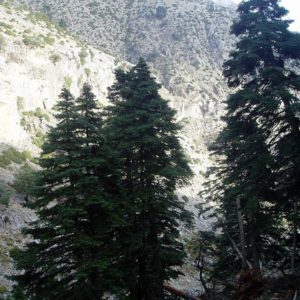
Spanish Fir Seed
Abies pinsapo£5.00 – £11.00 inc. VATSpanish Fir is the National Tree of Andalucia and is now endangered. Narrowly conical in shape with stubby, evergreen grey-green needles giving an ornamental blue-ish appearance from afar. The smaller picture shows one of the few remaining Pinsapo ‘forests’ in the mountains of southern Spain nature reserve area(Grazalema). The trees grow in pockets of soil on the mountainsides. In the valleys are nurseries which are growing trees for replanting into the wild. The nature reserve also holds wild Narcissus and Crocus species.
Not for forestry purposes.
-
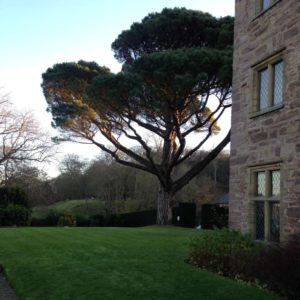
Stone Pine Seed
Pinus pinea£6.00 – £10.00 inc. VATStone Pine is the conifer that is exploited for its edible pine nut/seed(think Pesto and Italian Cuisine), It has a short trunk and an umbrella-like growth habit, giving mature trees a flat crown. It has attractive glaucous blue-green leaves in younger specimens and is sometimes sold as a pot grown mini Christmas tree. It is the classic flat-topped pine tree of Italy.
Not for forestry purposes.
-
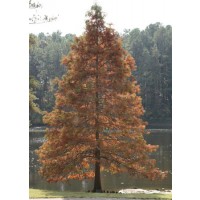
Swamp Cypress Seed
Taxodium distichum£5.00 – £9.50 inc. VATThe Swamp Cypress is an ideal conifer for wet soils. It is the dominant tree in the everglades of Florida and introduced to the UK in the mid 1600s. In the autumn, the soft leaflets fade to a beautiful bronze and then brown in autumn before dropping – a rare deciduous conifer. This tree is easy to confuse with Metasequoia(Dawn Redwood), but Taxodium has branches and leaflets arranged alternately, whereas Metasequoia has them arranged in pairs, opposite each other. The bark is stringy and shaggy and mature trees in wet areas grow ‘knees’ or odd bits of trunk erupting from the ground round the main trunk (pneumatophores). Despite its name, it doesn’t necessarily need to be planted in a wet place.
-
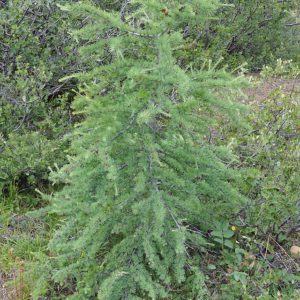
Tamarack Seed
Larix laricina£5.00 – £18.00 inc. VATThis American Larch is deciduous, like others and grows to be a tall columnar tree. It has pinkish orange to dark red bark becoming scaly when old. Needles are spirally arranged on long shoots. Before needle drop in autumn they turn orange. It’s widely distributed in North America, in swampy boreal forests and is very hardy and tolerant.
-
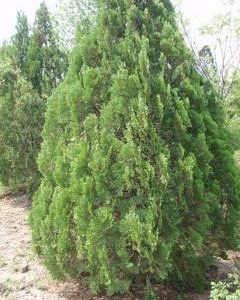
Tree of Life or Chinese Arborvitae Seed
Thuja orientalis£6.50 inc. VATThe Tree of Life or Chinese Arborvitae is a small slow growing conifer that is often grown as an ornamental. It makes a close, even, broad conical shape. In its native China it is associated with long life and vitality – hence its name of Chinese Arborvitae or Tree of Life. It is often planted in cemeteries and graveyards in UK. Foliage fronds are made up of flat scale-like leaves which are citrus aromatic when crushed and in a hard winter turn brownish green. The timber is quite pale and easy to work, being soft.
Pic by Fanghong, CC BY-SA 3.0 , via Wikimedia Commons
-
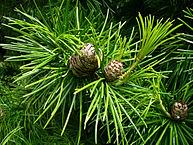
Umbrella Pine Seed
Sciadopitys verticillata£2.50 – £9.50 inc. VATA curious conifer native to upland areas of two of the large Japanese islands. The needles are made up of two fused leaves and appear upside-down in that their shiny surface faces downwards.
-
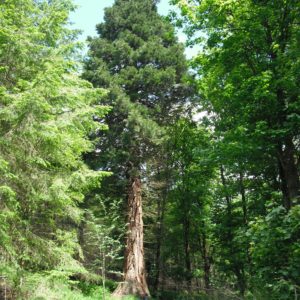
Wellingtonia Seed
Sequoiadendron giganteum£5.00 – £15.00 inc. VATWellingtonia is a Californian giant, not as tall, but with a wider girth than the Californian Redwood (Sequoia sempervirens) Young specimens are conical and densely branched producing a large elegant evergreen tree. The leaves are similar to Leyland cypress, being shortish hard scales. Thick rusty coloured fibrous bark, fissured and ridged when mature, but very soft.
-
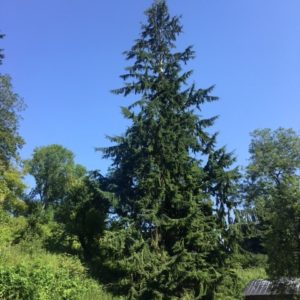
Western Hemlock Seed
Tsuga heterophylla£5.00 – £15.00 inc. VATWestern Hemlock is a large fast growing conifer with spreading branches. It produces an outstandingly beautiful single specimen tree with an elegant spire-like crown. The leaves are marked with two white bands underneath, soft and a bit like Yew but are aromatic(grapefruit or citrus) when crushed. Associated with Douglas Firs and Sitka Spruce on the Pacific coast of America, growing in the shade of other trees. When young, growth is slow, but picks up after 2 or 3 years.
-
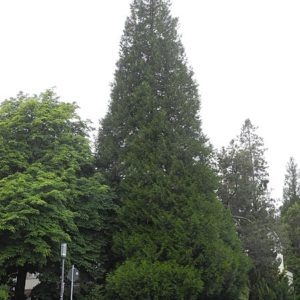
Western Red Cedar Seed
Thuja plicata£5.00 – £15.00 inc. VATWestern Red Cedar is a large fast growing tree with shredding bark and spreading branches. The leaves are bright glossy green forming an excellent hedge which clips well. Foliage is aromatic. Trees are grown commercially for cutting into planks for cladding and fencing and shingles. The timber is very resinous so doesn’t rot.
pic courtesy of Baummapper, CC BY-SA 3.0 , via Wikimedia Commons
-
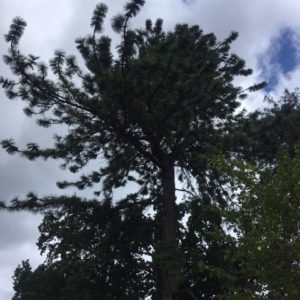
Western Yellow Pine Seed
Pinus ponderosa£6.00 – £15.00 inc. VATWestern Yellow Pine is a large striking conifer with a scaly cinnamon bark and drooping branches. Planted as an ornamental tree in large gardens as well as for timber production in its native western North America. Needles grow in threes and even when old the crown is narrowly conical. The bark is said to smell of turpentine, but not as strongly as Pinus jeffreyii.
-
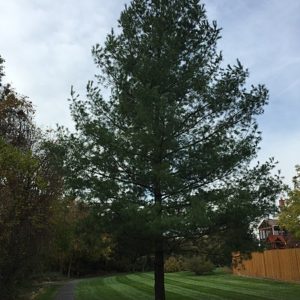
White / Weymouth Pine Seed
Pinus strobus£5.00 – £10.00 inc. VATWhite or Weymouth Pine is usually planted in gardens and parks as a specimen tree. It has very short dark green needles, in bundles of 5 and the cones are slender and brown up to 15cm long. It is fast growing and ornamental. In the past it has been used as a timber tree, and still is in America. It was used for the masts of sailing ships and was the cause of The Pine Riots in the American Civil War, because the colonists objected to the export of the finest trees to England! (early trade wars?!) Called the Weymouth Pine after Captain Weymouth who first brought the seed back the England, not because of where it grows!
pic courtesy of Famartin, CC BY-SA 4.0 , via Wikimedia Commons


Sign up to receive great news and offers